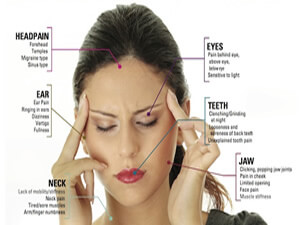When you have a headache, you might not think your jaw could be the cause, but, the TMJ, or temporomandibular joint, could be the culprit.
The TMJ is the hinge connecting your jaw to your skull. It allows you to do things like talk, laugh, and chew, and enables your jaw to move up and down and side to side.
Due to the hinge and sliding motions, this joint is a bit more complicated than other joints in the body and can cause a variety of symptoms if there is something amiss, including headaches. These are typically called temporomandibular disorders (TMD).
While it’s not known what causes a TMD, it could be something as simple as consistent teeth grinding. TMJ pain has been reported in 1 in 10 people, and TMD has been reported in almost half of the population of the United States.
There are no specific statistics about TMJ headaches because it can be hard to distinguish between general headaches and TMJ headaches.
The muscles of the TMJ run along your jaw and cheeks, and sometimes these muscles can cause pain — even headaches. When the muscles in your jaw tense up — like when you grind your teeth — the pain can spread to other TMJ muscles alongside your cheeks and on the sides and top of your head, causing a headache.
A TMJ headache might also result from TMJ issues related to osteoarthritis, joint hypermobility, or osteoporosis.
Babylon by TELUS Health lets you see a local doctor right from your phone—day or night, 7 days a week. The app is free to download and consultations are covered by MSP.
There are many different kinds of headaches, but TMJ headaches typically occur with other symptoms. These can include:
- tight facial or jaw muscles
- jaw or facial pain
- a “clicking” noise in the jaw
- restricted movement of the jaw
- changes in your bite (that is, the way your top and bottom teeth fit together)
TMJ headaches also often recur in one or more regions of the head and face or can feel like tension headaches.
For many TMJ disorders, including TMJ headaches, more studies are needed to establish a safe and reliable treatment plan. Because of this, conservative treatments are often recommended. Many treatments are things you can do fairly easily.
Lifestyle changes
Changing small behaviors associated with your jaw can be helpful, including:
- avoiding hard or chewy food
- reducing stress to prevent coping behaviors like jaw clenching
- avoiding jaw movements like those that happen with wide yawning or gum chewing
To manage pain caused by TMJ, short-term use of nonsteroidal anti-inflammatory medication (NSAIDs) can reduce jaw pain and headache. This includes aspirin (Excedrin), ibuprofen (Advil), and naproxen (Aleve).
Icing your jaw can also help relieve pain.
Practicing jaw exercises can help relax your muscles and relieve your symptoms.
Doctor-prescribed treatments
If lifestyle changes and over the counter medications aren’t helping your symptoms, make an appointment with your doctor. They may be able to prescribe stronger medications. The Healthline FindCare tool can provide options in your area if you don’t already have a doctor.
If noninvasive, conservative remedies aren’t helpful, talk with your doctor about other options. They might want to prescribe something stronger for the discomfort or suggest something like a stabilization splint (bite guard). Your dentist can also give you a stabilization splint.
Splints are a common treatment for TMJ. Although they protect your teeth if you’re grinding them, they haven’t been conclusively shown to relieve pain.
These, along with the treatments mentioned previously, are still only temporary, reversible treatments. They shouldn’t be seen as permanent solutions.
Surgical treatments
There are other, more permanent treatments such as orthodontic work to permanently change your bite and other dental work.
However, none of these treatments have been proven to be effective.
Use extreme caution when considering a permanent treatment for TMJ headache pain. There is no board certification in TMJ disorders in either medicine or dentistry, so finding a doctor with familiarity and experience in treating TMJ pain and headache can be challenging.
Another option might be speaking with a doctor in a pain clinic associated with a hospital or university. This might be especially helpful in figuring out the origin of the TMJ pain.
TMJ headaches are uncomfortable but may be treated by a variety of remedies. If you think you may be experiencing TMJ headaches, talk with your doctor about your symptoms as well as things you’ve already tried to alleviate the pain, even if they haven’t been effective.
If the cause is your TMJ, treatments aiming at the root cause can help ease headache pain and allow you to take precautions to prevent future headaches.


